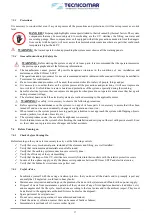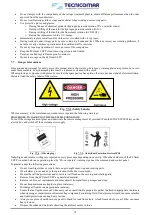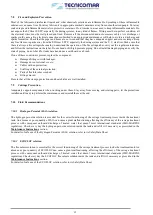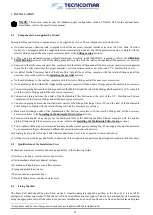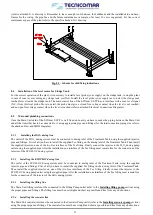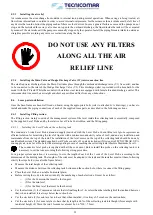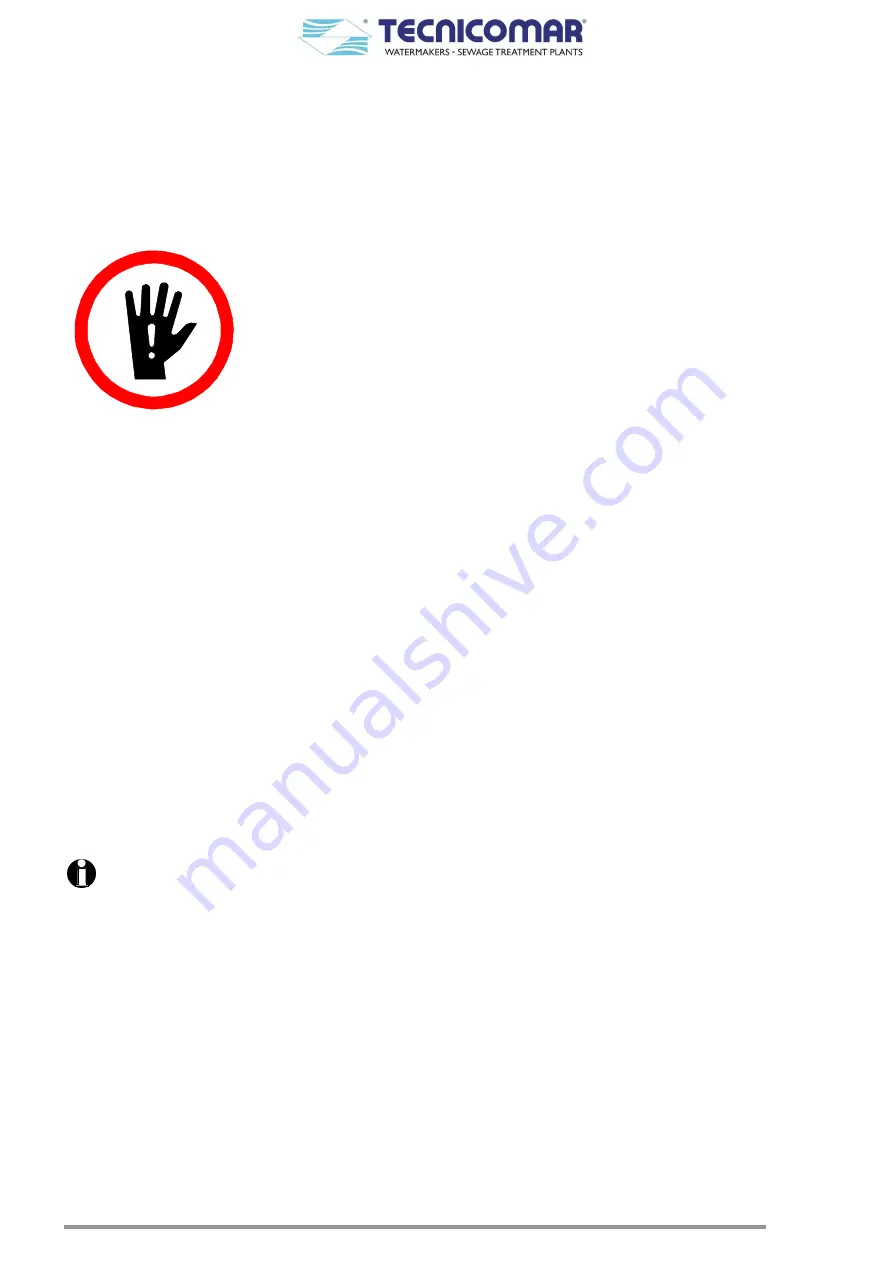
22
8.5.5
Installing the air relief
Air intake assure the air exchange from outside to internal tank, during normal operations. When sewage is being treated, air
flows from internal tank to outside in order to avoid internal overpressure; for these reasons the air intake must be left free of
any device that could obstruct the piping such as filters or other devices. In case a general failure occurs and the pumps do not
stop, and the motorized three way valve does not open to the outboard discharge, the liquid inside the tank will be evacuated
by means of the air intake until the pumps are manually stopped by the operator. Install the piping from air intake to outside as
straight as possible avoiding any curves or restrictions along the line.
DO NOT USE ANY FILTERS
ALONG ALL THE AIR
RELIEF LINE
8.5.6
Installing the Main Unit and Sludge Discharge Valve (V2) interconnection line
The clarified water discharge from the Main Unit takes place through the motorized discharge valve (V1) free outlet; and has
to be connected to the inlet of the Sludge Discharge Valve (V2). This discharge outlet is provided with a hose barb for the
model with the PP tank. While the models with stainless steel tank are equipped with female threaded discharge outlet. This
interconnection line must be as straight and short as possible and free from any obstructions.
8.6
Loose parts installation
Once the base-frame are been well fixed on board, using the appropriate bolts (refer to attached G.A. drawings), you have to
install and make the piping connections of each of the supplied loose parts, as described in the following sections.
8.6.1
Installing Filling section
The filling section mainly consists of the management system of the level inside the collecting tank is essentially, composed
by the supplied Level Probe and by the relative Level Probe Control Box; and the filling pump.
8.6.1.1
Installing the Level Probe on the collecting tank
The conductive 3-rods Level Probe (standard supply) matched with the Level Probe Control Box level probe represents an
efficient solution for monitoring the level of liquids with a minimum conductivity value of 1mS, and an easy installation and
maintenance from the top of the tank. The installation of the level sensor on the top of the collecting tank should be done by
qualified technicians. The standard supplied Level Probe consists of 3 coated electrodes (if it is require TECNICOMAR S.P.A.
con supply a 4-rods Level Probe for the alarm signaling in case of reaching the collecting tank Absolute Maximum Level).
The conductive level probe is supplied with all the rods uncut. Before install the probe on the collecting tank, it is
necessary to cut the rods according the following sizing procedure.
For a proper system operation it is necessary to size the length of each of the 3 rods of the Level Probe, according to the
dimensions of the holding tank. The lengths of the rods must be adapted to the tank and the installer must cut them, following
strictly the steps below (see also the figure below):
•
Measure the total height of the collecting tank;
•
Measure the distance between the collecting tank bottom and the suction hole, where to connect the filling pump.
•
Place the Level Probe on a stable horizontal plain;
•
Before cutting the rods (electrodes) identify the numbering of each electrode. It must be as follow:
o
(1) for the Common, that must be the longest,
o
(2) for the min level,
o
(3) for the Max level that must be the shortest;
•
Cut the electrode (1) for Common as to have that its final length is 3-4 cm less than the total height of the tank and however
that, when installed, it is always below the suction hole;
•
Cut the electrode (2) for min level as to have that, when installed, it is always 2-5cm above the suction hole;
•
Cut the electrode (3) for max level as to have that its length is 60% of the collecting tank total height (for example with
tank total height of 120cm the rod 3 for max level must be: 0.6*120 = 72cm).










